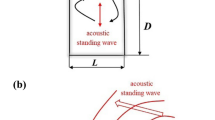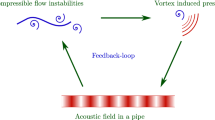Abstract
Pressure pulsations are inevitable in hydraulic transmission systems. Orifices are employed to damp pressure pulsation to improve the system control accuracy. In the present study, a frequency dispersion model based on Biot’s theory is implemented to describe phase velocity-frequency and amplitude attenuation-frequency characteristics of pressure pulsation. One contribution of this research is underlined as the quantification of the flow characteristics impacts from parameters, i.e., frequency, beta ratio β, and orifice length. Consequently, the pressure pulsation is decomposed into two types of dilatational waves propagating within the orifice via hydraulic oil. The numerical results confirm the second dilatational wave type is considerable in this object of research. The results obtained in the present study have been compared with CFD simulation results and they show a good agreement. According to the Reynolds number Re, the flow regime in the slender orifice is laminar. Introduction of an orifice with β = 0.20 for two distinct frequencies, the flow regime transitions from laminar to turbulence.










Similar content being viewed by others

References
Abd HM, Alomar OR, Mohamed IEA (2019) Effects of varying orifice diameter and Reynolds number on discharge coefficient and wall pressure. Flow Meas Instrum 65:219–226
Bae J, Chung W, Kim SB, Jang J (2014) A study on pressure and flow pulsation of swash plate type variable piston pump through analysis of pulsation variables and valve plate notch design for automation of hydraulic system. In: 2014 IEEE International conference on mechatronics and automation, pp 418–423
Benhamadouche S, Arenas M, Malouf W (2017) Wall-resolved Large Eddy Simulation of a flow through a square-edged orifice in a round pipe at Re = 25,000. Nucl Eng Des 312:128–136
Biot MA (1956a) “theory of propagations of elastic waves in a fluid-saturated porous solid. I. low-frequency range. J Acoust Soc Am 28(2):168–178
Biot MA (1956b) “theory of propagations of elastic waves in a fluid-saturated porous solid II high-frequency range. J Acoust Soc Am 28(2):179–191
Bohra LK, Mincks LM, Garimella SS (2020) Experimental investigation of pressure drop characteristics of viscous fluid flow through small diameter orifices. J Fluids Eng Trans Asme 143:1–12
Cao W, Liu Y, Dong J, Niu Z, Shi Y (2019) Research on pressure pulsation characteristics of gerotor pump for active vibration damping system. IEEE Access 7:116567–116577
Cieszko M, Kubik J (2020) Equations and fundamental characteristics of transverse waves propagating in fluid-saturated porous materials. Int J Eng Sci 152:103292
Cyklis P, Młynarczyk P (2016) The CFD based estimation of pressure pulsation damping parameters for the manifold element. Proc Eng 157:387–395
Domenichini F (2011) Three-dimensional impulsive vortex formation from slender orifices. J Fluid Mech 666:506–520
Earnhart NE, Cunefare K (2012) Compact Helmholtz resonators for hydraulic systems. Int J Fluid Power 13:41–50
Gao P, Zhai J, Han Q (2019) Dynamic response analysis of aero hydraulic pipeline system under pump fluid pressure fluctuation. Proc Inst Mech Eng Part g J Aerosp Eng 233:1585–1595
Hayashi I, Kaneko S (2014) Pressure pulsations in piping system excited by a centrifugal turbomachinery taking the damping characteristics into consideration. J Fluids Struct 45:216–234
Hayong MJXBY (2010) Modeling and experiment study on fluid character of axial piston pump. Trans Chin Soc Agric Mach 41(1):188–194
Herrmann J, Koreck J, Maess M, Gaul L, Estorff O (2011) Frequency-dependent damping model for the hydroacoustic finite element analysis of fluid-filled pipes with diameter changes. Mech Syst Signal Process 25:981–990
Hu H, Wang K (2001) Dynamic permeability in porous medium acoustics. Chin J Geophys 44:135–142
Johnson D, Plona T, Scala C, Pasierb F, Kojima H (1982) Tortuosity and acoustic slow waves. Phys Rev Lett 49:1840–1844
Li Q, Liu W, Lu K, Yue Z (2020) Nonlinear parametric vibration of a fluid-conveying pipe flexibly restrained at the ends. Acta Mech Solida Sin 33:327–346
Min W, Wang H, Zheng Z, Wang D, Ji H, Wang Y (2020) Visual experimental investigation on the stability of pressure regulating poppet valve. Proc Inst Mech Eng C J Mech Eng Sci 234:2329–2348
Mironova T, Prokofiev A, Panova V (2018) The mathematical model of pipeline system with pressure pulsation damper under force excitation by oscillating fluid flow. In: 2018 Global Fluid Power Society PhD Symposium (GFPS) pp 1–8
Pałczyński T (2017) A hybrid method of estimating pulsating flow parameters in the space-time domain. Mech Syst Signal Process 89:58–66
Qiu X, Duan J-S, Luo J, Kaloni P, Liu Y (2013) Parameter effects on shear stress of Johnson-Segalman fluid in Poiseuille flow. Int J Non-Linear Mech 55:140–146
Reis MN, Hanriot S (2017) Incompressible pulsating flow for low Reynolds numbers in orifice plates. Flow Meas Instrum 54:146–157
Rydlewicz W, Rydlewicz M, Pałczyński T (2019) Experimental investigation of the influence of an orifice plate on the pressure pulsation amplitude in the pulsating flow in a straight pipe. Mech Syst Signal Process 117:634–652
Semrau S, Skoda R, Wustmann W, Habr K (2019) Experimental and numerical investigation of noise generation due to acoustic resonance in a cavitating valve. J Sound Vib 463:114956
Shaaban S (2014) Optimization of orifice meter’s energy consumption. Chem Eng Res Des 92:1005–1015
Shah M, Joshi JB, Kalsi AS, Prasad CSR, Shukla DS (2012) Analysis of flow through an orifice meter: CFD simulation. Chem Eng Sci 71:300–309
Shan F, Fujishiro A, Tsuneyoshi T, Tsuji Y (2013) Particle image velocimetry measurements of flow field behind a circular square-edged orifice in a round pipe. Exp Fluids 54:1–18
Shan F, Liu Z, Liu W, Tsuji Y (2016) Effects of the orifice to pipe diameter ratio on orifice flows. Chem Eng Sci 152:497–506
Siba MA, Mahmood WMF, Nuawi MZ, Rasani R, Nassir MH (2015) Modeling and applications of 3 D flow in orifice plate at low turbulent Reynolds numbers. Int J Mech Mechatron Eng IJMME-IJENS 15(4):19–25
Tang T, Gao L, Li B, Liao L, Xi Y, Yang G (2019) Cavitation optimization of a throttle orifice plate based on three-dimensional genetic algorithm and topology optimization. Struct Multidiscip Optim 60(3):1227–1244
Tang T, Yang G, Zhang D, Lei L, Li B, Gao L (2020) A hydrodynamic prediction model of throttle orifice plate using space filling and adaptive sampling method. Struct Multidiscip Optim 62:1563–1578
Tsiklauri D, Beresnev I (2001) Properties of elastic waves in a non-newtonian (Maxwell) fluid-saturated porous medium. Transp Porous Media 53:39–50
Tsuji T, Maekawa A, Tsuneo A, Takahashi T, Noda M, Kato M, Fujita K (2011) Experiment and simulation on pressure pulsation accompanied by acoustic resonance and piping vibration. Press Vessels Pip Conf 44540:163–173
Xiumei L, Jie H, Beibei L, Chi Z, Huawen X, Wei L, Fangwei X (2021) Study on unsteady cavitation flow and pressure pulsation characteristics in the regulating valve. Shock Vib 2021:1–10
Ye J, Zeng W, Zhao Z, Yang J, Yang J (2020) Optimization of pump turbine closing operation to minimize water hammer and pulsating pressures during load rejection. Energies 13(4):1000
Yin G, Nitter B, Ong MC (2020a) Numerical simulations of turbulent flow through an orifice plate in a pipe. J Offshore Mech Arctic Eng Trans Asme pp 1–11
Yin G, Nitter B, Ong MC (2020b) Numerical simulations of turbulent flow through an orifice plate in a pipe. J Offshore Mech Arctic Eng Trans Asme pp 1–11
Acknowledgements
Research is funded by the National Natural Science Foundation of China (52065007), the Guizhou Science and Technology Project (Guizhou Science and Technology Platform [2018]5781).
Author information
Authors and Affiliations
Corresponding author
Rights and permissions
About this article
Cite this article
Yu, L., Wei, W., Yanlei, L. et al. Orifice Frequency Dispersion Characteristics Effect on Hydraulic System Pressure Pulsation. Iran J Sci Technol Trans Mech Eng 46, 793–803 (2022). https://doi.org/10.1007/s40997-022-00487-z
Received:
Accepted:
Published:
Issue Date:
DOI: https://doi.org/10.1007/s40997-022-00487-z



